 | ||
Conversion of units is the conversion between different units of measurement for the same quantity, typically through multiplicative conversion factors.
Contents
Process overview
The process of conversion depends on the specific situation and the intended purpose. This may be governed by regulation, contract, technical specifications or other published standards. Engineering judgment may include such factors as:
Some conversions from one system of units to another need to be exact, without increasing or decreasing the precision of the first measurement. This is sometimes called soft conversion. It does not involve changing the physical configuration of the item being measured.
By contrast, a hard conversion or an adaptive conversion may not be exactly equivalent. It changes the measurement to convenient and workable numbers and units in the new system. It sometimes involves a slightly different configuration, or size substitution, of the item. Nominal values are sometimes allowed and used.
Conversion factors
A conversion factor is used to change the units of a measured quantity without changing its value. The unity bracket method of unit conversion consists of a fraction in which the denominator is equal to the numerator, but they are in different units. Because of the identity property of multiplication, the value of a number will not change as long as it is multiplied by one. Also, if the numerator and denominator of a fraction are equal to each other, then the fraction is equal to one. So as long as the numerator and denominator of the fraction are equivalent, they will not affect the value of the measured quantity.
Software tools
There are many conversion tools. They are found in the function libraries of applications such as spreadsheets databases, in calculators, and in macro packages and plugins for many other applications such as the mathematical, scientific and technical applications.
There are many standalone applications that offer the thousands of the various units with conversions. For example, the free software movement offers a command line utility GNU units for Linux and Windows.
Tables of conversion factors
This article gives lists of conversion factors for each of a number of physical quantities, which are listed in the index. For each physical quantity, a number of different units (some only of historical interest) are shown and expressed in terms of the corresponding SI unit. Conversion between units in the metric system can be discerned by their prefixes (for example, 1 kilogram = 1000 grams, 1 milligram = 0.001 grams) and are thus not listed in this article. Exceptions are made if the unit is commonly known by another name (for example, 1 micron = 10−6 metre). Within each table, the units are listed alphabetically, and the SI units (base or derived) are highlighted.
Mass
Notes:
Speed or velocity
A velocity consists of a speed combined with a direction; the speed part of the velocity takes units of speed.
Force
See also: Conversion between weight (force) and mass
Information entropy
Often, information entropy is measured in shannons, whereas the (discrete) storage space of digital devices is measured in bits. Thus, uncompressed redundant data occupy more than one bit of storage per shannon of information entropy. The multiples of a bit listed above are usually used with this meaning. Other times the bit is used as a measure of information entropy and is thus a synonym of shannon.
Luminous intensity
The candela is the preferred nomenclature for the SI unit.
Radiation - source activity
Please note that although becquerel (Bq) and hertz (Hz) both ultimately refer to the same SI base unit (s−1), Hz is used only for periodic phenomena, and Bq is only used for stochastic processes associated with radioactivity.
Radiation - exposure
The roentgen is not an SI unit and the NIST strongly discourages its continued use.
Radiation - equivalent dose
Although the definitions for sievert (Sv) and gray (Gy) would seem to indicate that they measure the same quantities, this is not the case. The effect of receiving a certain dose of radiation (given as Gy) is variable and depends on many factors, thus a new unit was needed to denote the biological effectiveness of that dose on the body; this is known as the equivalent dose and is shown in Sv. The general relationship between absorbed dose and equivalent dose can be represented as
H = Q · Dwhere H is the equivalent dose, D is the absorbed dose, and Q is a dimensionless quality factor. Thus, for any quantity of D measured in Gy, the numerical value for H measured in Sv may be different.
